The Museum of Natural History
Moderator: Azjah von Drachen Walde
- Azjah von Drachen Walde
- Expert Adventurer

- Posts: 1138
- Joined: Mon Apr 04, 2005 1:13 am
- Location: Palazzo Drachen Walde
- Contact:
The Museum of Natural History
The Museum of Natural History: The first set of doors on the far side of the entrance lead to the Museum of Natural History. This section of the buildings is reserved for the study of life. One well known researcher is quoted on a plaque to the left of the entry doors:
Natural history is the scientific study of plants and animals in their natural environments. It is concerned with levels of organization from the individual organism to the ecosystem, and stresses identification, life history, distribution, abundance, and inter-relationships. It often and appropriately includes an esthetic component.
—Stephen G. Herman, 2002
Housed within the RhyDin Museum of Natural history are the various plants, animals and geological phenomenon to explain how the natural world functions.
The mineralogy department is housed in the Museum of Natural History, along with plant collections, and exhibits of the major ecosystems on RhyDin.
Natural history is the scientific study of plants and animals in their natural environments. It is concerned with levels of organization from the individual organism to the ecosystem, and stresses identification, life history, distribution, abundance, and inter-relationships. It often and appropriately includes an esthetic component.
—Stephen G. Herman, 2002
Housed within the RhyDin Museum of Natural history are the various plants, animals and geological phenomenon to explain how the natural world functions.
The mineralogy department is housed in the Museum of Natural History, along with plant collections, and exhibits of the major ecosystems on RhyDin.
Azjah Telyria Danaan
Marchioness von Triberg
Baroness von Drachen Walde
Marchioness von Triberg
Baroness von Drachen Walde
- Azjah von Drachen Walde
- Expert Adventurer

- Posts: 1138
- Joined: Mon Apr 04, 2005 1:13 am
- Location: Palazzo Drachen Walde
- Contact:
Mineralogy Donation
The Museum of Natural History in RhyDin had been small, and from all appearances to Azjah’s mind, woefully neglected. She’s spoken to the Curator, and had promised to return with a mineral exhibit that she would put on long term loan to the Museum.
Some of her collection was simply too rare to donate permanently, but if they went to the Museum, more people could see them, and they would serve a wider purpose.
She’d already decided to donate the large sapphire from the mining project, and thankfully it wasn’t one that Kairee had any interest in. The sapphire was the largest, purest example ever found. It would form a fine centerpiece for the display she had in mind.
Dyson listened to her instructions and made a few mental notes before leaving to find the specimens. Most of them would be in the library, but the most valuable ones he would need to open the safe.
In the morning, Azjah found the specimen’s laid out neatly along with a data sheet for each one neatly formatted on Drachen Walde stationary.
Some of her collection was simply too rare to donate permanently, but if they went to the Museum, more people could see them, and they would serve a wider purpose.
She’d already decided to donate the large sapphire from the mining project, and thankfully it wasn’t one that Kairee had any interest in. The sapphire was the largest, purest example ever found. It would form a fine centerpiece for the display she had in mind.
Dyson listened to her instructions and made a few mental notes before leaving to find the specimens. Most of them would be in the library, but the most valuable ones he would need to open the safe.
In the morning, Azjah found the specimen’s laid out neatly along with a data sheet for each one neatly formatted on Drachen Walde stationary.
Azjah Telyria Danaan
Marchioness von Triberg
Baroness von Drachen Walde
Marchioness von Triberg
Baroness von Drachen Walde
- Azjah von Drachen Walde
- Expert Adventurer

- Posts: 1138
- Joined: Mon Apr 04, 2005 1:13 am
- Location: Palazzo Drachen Walde
- Contact:
Sapphire
1) Sapphire : Blue variety of the mineral corundum. The blue coloring comes from the impurity of titanium. The name sapphire is probably derived through the Latin sapphires and Greek sápheiros.
. a. Gem quality corundum originates from metamorphic basic rocks that contain aluminum rich minerals, and in some aluminum rich igneous rocks. Associated with sapphire are minerals such as spinel, periclase, tourmaline, kyanite, magnetite, chlorite and nephelinite.
. b. The crystal system is trigonal, and has a Moh’s Hardness of 9. These are the hardest gems with only diamond exhibiting a Moh’s Hardness of 10. Density averages 4.0 grams/cubic centimeter of mineral.
. c. Sapphires of this purity are extremely rare, and the deep blue coloring in a stone weighing 42 carats has never been documented previously.
. d.The distinctive characteristics are sapphires include striking luster, blue-green pleochroism, and in the case of star sapphires, needles of rutile.
. i..(Pleochroism is the breaking up of light into two parts. Each of the rays travels at a different velocity resulting in doubly refracted light)


. a. Gem quality corundum originates from metamorphic basic rocks that contain aluminum rich minerals, and in some aluminum rich igneous rocks. Associated with sapphire are minerals such as spinel, periclase, tourmaline, kyanite, magnetite, chlorite and nephelinite.
. b. The crystal system is trigonal, and has a Moh’s Hardness of 9. These are the hardest gems with only diamond exhibiting a Moh’s Hardness of 10. Density averages 4.0 grams/cubic centimeter of mineral.
. c. Sapphires of this purity are extremely rare, and the deep blue coloring in a stone weighing 42 carats has never been documented previously.
. d.The distinctive characteristics are sapphires include striking luster, blue-green pleochroism, and in the case of star sapphires, needles of rutile.
. i..(Pleochroism is the breaking up of light into two parts. Each of the rays travels at a different velocity resulting in doubly refracted light)


Azjah Telyria Danaan
Marchioness von Triberg
Baroness von Drachen Walde
Marchioness von Triberg
Baroness von Drachen Walde
- Azjah von Drachen Walde
- Expert Adventurer

- Posts: 1138
- Joined: Mon Apr 04, 2005 1:13 am
- Location: Palazzo Drachen Walde
- Contact:
Ruby - Corundum
2) Ruby: Red variety of the mineral corundum. This is the most highly prized gem of the corundum series. The name Ruby comes from the Latin Rubrum for red.
. a. Color varies from pale pink shades to vibrant violet red. This gem is pleochroic, and different colors are found in the same sample.
. b. The crystal system is trigonal, and has a Moh’s Hardness of 9. These are the hardest gems with only diamond exhibiting a Moh’s Hardness of 10. Density averages 4.0 grams/cubic centimeter of mineral.
. c. Rubies in excess of 3 carats at this purity are exceedingly rare and can command prices in excess of diamonds for similar purity and size.

. a. Color varies from pale pink shades to vibrant violet red. This gem is pleochroic, and different colors are found in the same sample.
. b. The crystal system is trigonal, and has a Moh’s Hardness of 9. These are the hardest gems with only diamond exhibiting a Moh’s Hardness of 10. Density averages 4.0 grams/cubic centimeter of mineral.
. c. Rubies in excess of 3 carats at this purity are exceedingly rare and can command prices in excess of diamonds for similar purity and size.

Azjah Telyria Danaan
Marchioness von Triberg
Baroness von Drachen Walde
Marchioness von Triberg
Baroness von Drachen Walde
- Azjah von Drachen Walde
- Expert Adventurer

- Posts: 1138
- Joined: Mon Apr 04, 2005 1:13 am
- Location: Palazzo Drachen Walde
- Contact:
Chrysoberyl
3) Chrysoberyl: Also know as golden chrysoberyl, a synonym, the prefix “chryso” being Greek for “golden”. This sample is the common form of twinned crystal structure.
a. The color can vary from yellow to greenish-yellow.
b. The mineral is orthorhombic which lends itself to easy twinning.
c. It is derived from beryllium aluminates, having a Moh’s hardness of 8.5. Specific gravity between 3.5 – 3.8. Generally found in granite pegmatites and metamorphic gneisses.
d. Pleochroic in the green and brown varieties.


Alexandrite - Beryl gem
a. The color can vary from yellow to greenish-yellow.
b. The mineral is orthorhombic which lends itself to easy twinning.
c. It is derived from beryllium aluminates, having a Moh’s hardness of 8.5. Specific gravity between 3.5 – 3.8. Generally found in granite pegmatites and metamorphic gneisses.
d. Pleochroic in the green and brown varieties.


Alexandrite - Beryl gem
Azjah Telyria Danaan
Marchioness von Triberg
Baroness von Drachen Walde
Marchioness von Triberg
Baroness von Drachen Walde
- Azjah von Drachen Walde
- Expert Adventurer

- Posts: 1138
- Joined: Mon Apr 04, 2005 1:13 am
- Location: Palazzo Drachen Walde
- Contact:
Topaz
4) Topaz: This is a silicate of aluminum containing fluorine and hydroxyl. The name Topaz was originally applied to an olivine mineral taken from the Island of Topazos, but came into use for the mineral we call Topaz today in the first half of the 18th century.
a. Crystal system is orthorhombic, and crystals are often found in prismatic form, sometimes with the terminal faces intact. They have perfect basal cleavage.
b. Colors range from white, semi-opaque to colorless, honey-brown, to rare pinks and reds.
c. Topaz has a hardness of 8 and density of 3.52 – 3.56 grams per cubic centimeter.
d. Topazes richest in hydroxyl have a low density and high refractive indices.
e. Topaz is characteristic of pegmatites and pneumatolytic deposits. Therefore contact metamorphic zones are where the minerals are economically mined.
. i. (Cleavage: atomic structure of each mineral is unique, but fall into defined categories dependent on fixed angular relationships between atoms. Topaz has orthorhombic structure, which results in a relatively smooth and lustrous face when fractured.)
. ii. (Pegmatite: Generally associated with granites and syenites. The size of the grains and crystals are gigantic in relation to most rock formations. They are the premier source of economic mineral deposits.)
f. Yellow topaz is the most common form of Topaz used in jewelry. However, the easy basal cleavage makes this gem rather brittle.
g. Blue topaz has become the most prevalent form of Topaz sold today. The value of topaz is very low, which makes it readily available and sold for its brilliant blue shades in place of blue sapphire.



a. Crystal system is orthorhombic, and crystals are often found in prismatic form, sometimes with the terminal faces intact. They have perfect basal cleavage.
b. Colors range from white, semi-opaque to colorless, honey-brown, to rare pinks and reds.
c. Topaz has a hardness of 8 and density of 3.52 – 3.56 grams per cubic centimeter.
d. Topazes richest in hydroxyl have a low density and high refractive indices.
e. Topaz is characteristic of pegmatites and pneumatolytic deposits. Therefore contact metamorphic zones are where the minerals are economically mined.
. i. (Cleavage: atomic structure of each mineral is unique, but fall into defined categories dependent on fixed angular relationships between atoms. Topaz has orthorhombic structure, which results in a relatively smooth and lustrous face when fractured.)
. ii. (Pegmatite: Generally associated with granites and syenites. The size of the grains and crystals are gigantic in relation to most rock formations. They are the premier source of economic mineral deposits.)
f. Yellow topaz is the most common form of Topaz used in jewelry. However, the easy basal cleavage makes this gem rather brittle.
g. Blue topaz has become the most prevalent form of Topaz sold today. The value of topaz is very low, which makes it readily available and sold for its brilliant blue shades in place of blue sapphire.



Azjah Telyria Danaan
Marchioness von Triberg
Baroness von Drachen Walde
Marchioness von Triberg
Baroness von Drachen Walde
- Azjah von Drachen Walde
- Expert Adventurer

- Posts: 1138
- Joined: Mon Apr 04, 2005 1:13 am
- Location: Palazzo Drachen Walde
- Contact:
Emeralds - Beryl
5) Beryl: Emerald is the gem version of Beryl. Beryl is a silicate of beryllium and aluminum, with the green coming from impurities of Chromium and Vanadium.
. a. Chrystal system is hexagonal.
. b. Hardness ranges between 7.5-8 but is fairly brittle and has ill-defined cleavage along the basal plane.
. c. Density: 2.67 – 2.72 grams per centimeter. Refractive index, like density varies depending on aluminum content.
. d. Beryl is an accessory mineral in granitic pegmatites, where crystals have been discovered reaching 40 centimeters in length.
. e. The name ‘emerald’ is very ancient in origin. The Latin smaragdus appears to have referred to emeralds for the last 2200 years.
. f. The brilliant green is the most prized version of Beryl. The color is due to inclusions of Chromium atoms into the Beryl matrix.
. g. Stones of greater than 2 carats and good transparency are highly valued.

Emerald with host rock

Largest emerald ever found. 858 carats
. a. Chrystal system is hexagonal.
. b. Hardness ranges between 7.5-8 but is fairly brittle and has ill-defined cleavage along the basal plane.
. c. Density: 2.67 – 2.72 grams per centimeter. Refractive index, like density varies depending on aluminum content.
. d. Beryl is an accessory mineral in granitic pegmatites, where crystals have been discovered reaching 40 centimeters in length.
. e. The name ‘emerald’ is very ancient in origin. The Latin smaragdus appears to have referred to emeralds for the last 2200 years.
. f. The brilliant green is the most prized version of Beryl. The color is due to inclusions of Chromium atoms into the Beryl matrix.
. g. Stones of greater than 2 carats and good transparency are highly valued.

Emerald with host rock

Largest emerald ever found. 858 carats
Azjah Telyria Danaan
Marchioness von Triberg
Baroness von Drachen Walde
Marchioness von Triberg
Baroness von Drachen Walde
- Azjah von Drachen Walde
- Expert Adventurer

- Posts: 1138
- Joined: Mon Apr 04, 2005 1:13 am
- Location: Palazzo Drachen Walde
- Contact:
Cosmology and Astronomy
Cosmology Exhibit – Museum of Natural History
As you walk through the doors of the Cosmology Exhibit, the visitor is surrounded by a vast sensation of open space. The roof is a high dome, and everything is a velvet black. Seating for the Cosmology Exhibit is in the center of the large space, and small rows of white lights lead along the paths to the center of the room.
The seats are comfortable, plush affairs that are reclining, and will move as the story unfolds. The exhibit plays for approximately one hour, and repeats for 30 days before the exhibit is changed, and new items are substituted into the program.
Given the billions of stars in the night skies, this display will be ever changing as it takes the visitor off to places of unimaginable beauty and violence. The birth of stars, the growth of galaxies, and the ultimate death of a star all play out in compressed time for those fascinated with “What’s Out There”.
Tonight’s show will take visitors off first to visit the unusual structure called the Double Helix Nebula. It lies about 300 light years from a large black hole designated Sagittarius A at the center of our Milky Way galaxy. When viewed in the infra-red, this unusual reddish-orange cloud appears as a double Helix strand of DNA, and has been called “Cosmic DNA”. Seen through the image are several very large giant stars.
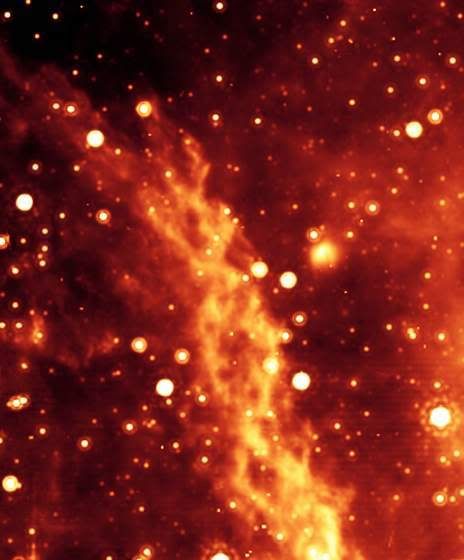
(Photo: NASA/JPL Caltech/ M. Morris (UCLA))
As you walk through the doors of the Cosmology Exhibit, the visitor is surrounded by a vast sensation of open space. The roof is a high dome, and everything is a velvet black. Seating for the Cosmology Exhibit is in the center of the large space, and small rows of white lights lead along the paths to the center of the room.
The seats are comfortable, plush affairs that are reclining, and will move as the story unfolds. The exhibit plays for approximately one hour, and repeats for 30 days before the exhibit is changed, and new items are substituted into the program.
Given the billions of stars in the night skies, this display will be ever changing as it takes the visitor off to places of unimaginable beauty and violence. The birth of stars, the growth of galaxies, and the ultimate death of a star all play out in compressed time for those fascinated with “What’s Out There”.
Tonight’s show will take visitors off first to visit the unusual structure called the Double Helix Nebula. It lies about 300 light years from a large black hole designated Sagittarius A at the center of our Milky Way galaxy. When viewed in the infra-red, this unusual reddish-orange cloud appears as a double Helix strand of DNA, and has been called “Cosmic DNA”. Seen through the image are several very large giant stars.

(Photo: NASA/JPL Caltech/ M. Morris (UCLA))
Azjah Telyria Danaan
Marchioness von Triberg
Baroness von Drachen Walde
Marchioness von Triberg
Baroness von Drachen Walde
- Azjah von Drachen Walde
- Expert Adventurer

- Posts: 1138
- Joined: Mon Apr 04, 2005 1:13 am
- Location: Palazzo Drachen Walde
- Contact:
ARP 220
The chairs shift and another section of sky comes to life. This time, instead of the warmth of the orange cloud of the Double Helix, we see a combination of cold blue, and fiery red as we witness a star factory. At the heart of galaxy Arp 220, located 250 million light years away in the direction of the constellation Serpens is a huge cluster of stars. These clusters of stars are twice the size of the largest known clusters in our own Milky Way, and tip the scales at more than 10 million solar masses. These are star nurseries and here the stars burn blue-white with vast amounts of energy. This area of space is a violent birthing ground for millions of stars.
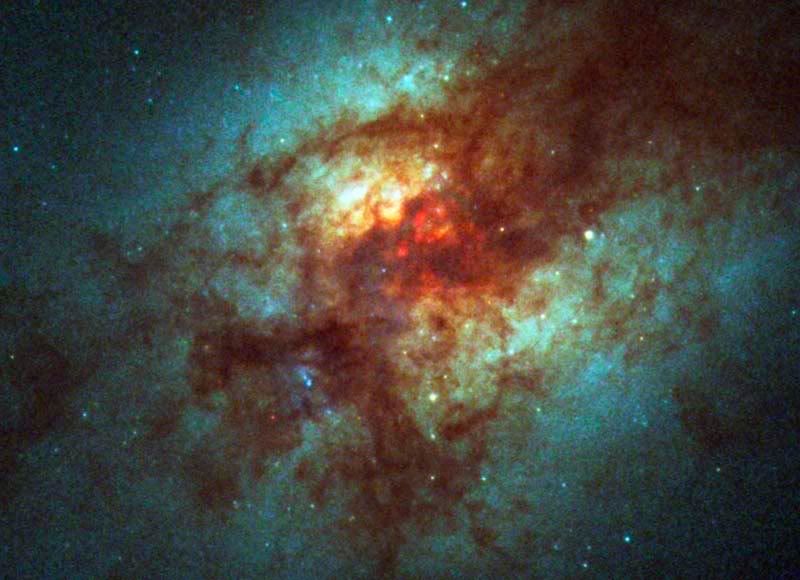
(Photo: NASA, ESA, and C. Wilson (McMaster University, Hamilton, Ontario, Canada)

(Photo: NASA, ESA, and C. Wilson (McMaster University, Hamilton, Ontario, Canada)
Azjah Telyria Danaan
Marchioness von Triberg
Baroness von Drachen Walde
Marchioness von Triberg
Baroness von Drachen Walde
- Azjah von Drachen Walde
- Expert Adventurer

- Posts: 1138
- Joined: Mon Apr 04, 2005 1:13 am
- Location: Palazzo Drachen Walde
- Contact:
NGC 5746
The chairs slowly turn as the skies overhead seem to wheel to a new view. Out of the blackness lights up a spiral galaxy, viewed nearly edge on, with the central disk glowing hotly, and a royal purple halo nearly reaches to the far edge of the spiral arms. Just to the left in the quadrant is a huge white star. We are introduced to NGC 5746. This massive spiral galaxy is in the constellation known as Virgo. The blue image is from the Chandra X-ray image overlaid onto an optical image of the galaxy, which reveals the superheated gas extending 60,000 light years on either size of the galactic disk. Data suggests the halo is actually matter left over from the formation of the galaxy that is gradually falling inward, and heating up in the process.
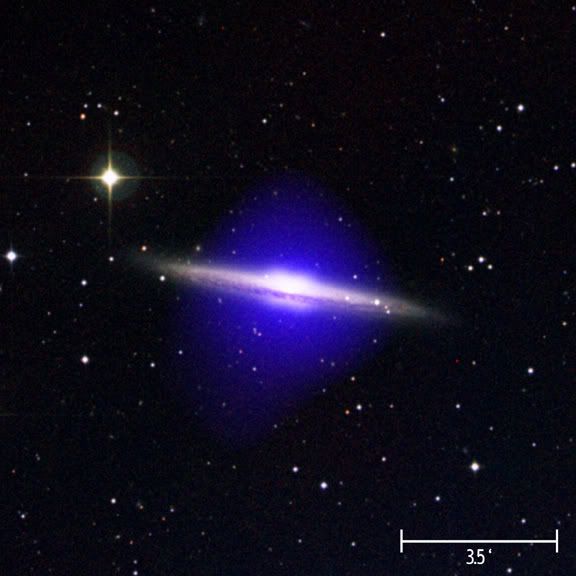
(Photo: NASA/CXCIU Copenhagen/Palomar DSS. K Pedersen et al)

(Photo: NASA/CXCIU Copenhagen/Palomar DSS. K Pedersen et al)
Azjah Telyria Danaan
Marchioness von Triberg
Baroness von Drachen Walde
Marchioness von Triberg
Baroness von Drachen Walde
Antennae
The sky darkens and guests are laid back nearly flat as an eruption of color blooms overhead. The complex beauty of two galaxies, NGC 4038 and 4039, bloom into view overhead. These are called “Antennae”. They are two interacting galaxies that are 62 million light years away in the constellation Corvus. Shades of glowing yellow, palest lavender pink, rich reds and stunning white create a dance of exquisite color in this image, The HST/ACS image is the sharpest yet captured and shows number “super” star clusters. The pink glow is ionized hydrogen, and spanning the bright yellow cores of the twisted galaxies are dark lanes of dust billowing through the maelstrom. This huge burst of stellar formation was triggered by tidal forces and is estimated to have begun 200 to 300 million years ago.
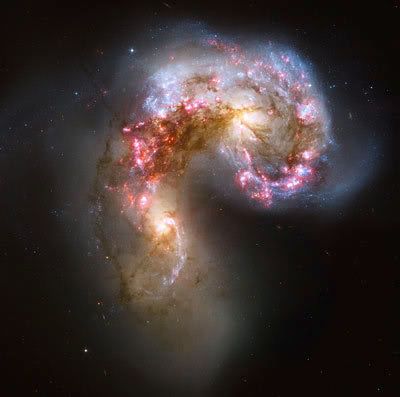
(Photo: NASA, ESA, and the Hubble Heritage Team (STScI/AURA) ESA/Hubble Collaboration)

(Photo: NASA, ESA, and the Hubble Heritage Team (STScI/AURA) ESA/Hubble Collaboration)
Lucien Datrazanov
- Azjah von Drachen Walde
- Expert Adventurer

- Posts: 1138
- Joined: Mon Apr 04, 2005 1:13 am
- Location: Palazzo Drachen Walde
- Contact:
SN 2003 gd
The glowing shades diminish and blackness once more reigns as visitors are moved to a new direction where a lavender spiral galaxy slowly illuminates. The outer arms of the galaxy are a vibrant lavender purple of glowing hydrogen in great quantities surround a white disk at the center. The infra-red eyes of the Spitzer Space Telescope see into the clouds surrounding these stars in the galaxy known as M74, which contains a supernova designated SN2003gd. The supernova is a dot of bright yellow-green amidst the lavender and white. Here, the infrared radiation of the dust created by the explosion is captured and demonstrates that interstellar dust is the by-product of the cataclysmic death of a star.
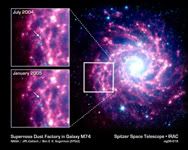
(Photo: SASA/JPL – Caltech/BEK Sugarman STScI)
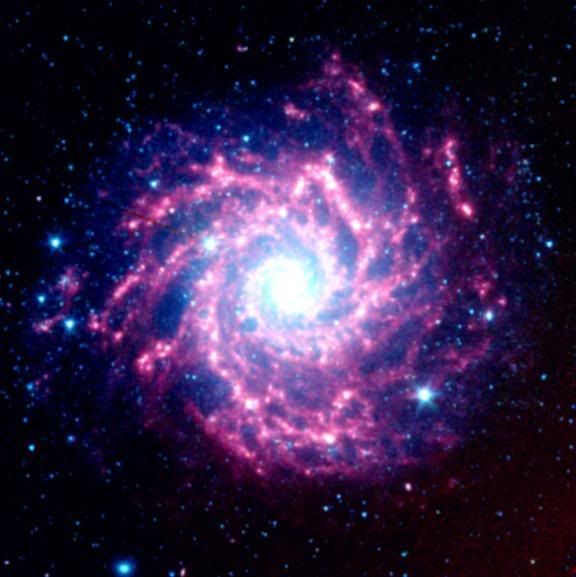

(Photo: SASA/JPL – Caltech/BEK Sugarman STScI)

Azjah Telyria Danaan
Marchioness von Triberg
Baroness von Drachen Walde
Marchioness von Triberg
Baroness von Drachen Walde
- Azjah von Drachen Walde
- Expert Adventurer

- Posts: 1138
- Joined: Mon Apr 04, 2005 1:13 am
- Location: Palazzo Drachen Walde
- Contact:
Merope
The room abruptly illuminates with a single huge star glowing overhead. A faint blue halo surrounds it and off to the left a small reddish star provides the only other color. This is Merope (Tauri 23); one of the brightest members of the Pleiades star cluster (M45) in the constellation Taurus. The bluish halo surrounding it results from the starlight reflecting from a cloud of carbon-rich dust surrounding the stars. The region surrounding Meriope is separately designated NGC 1435, and is more commonly called the Merope Nebula, or Tempei’s Nebula. This nebula was discovered by Wilhelm Tempei in 1859.
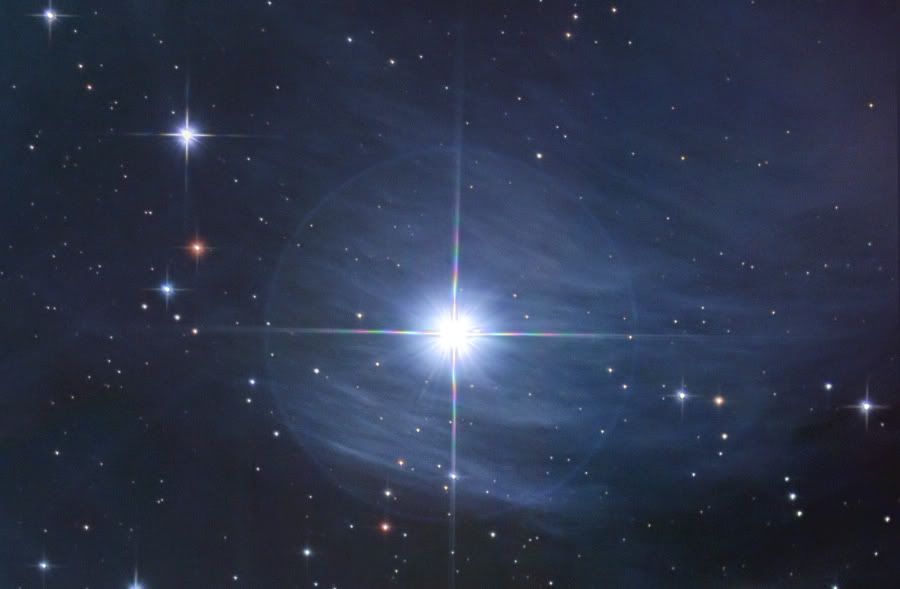
(Photo: Wolfgang Prompter (www.astro-pics.com)

(Photo: Wolfgang Prompter (www.astro-pics.com)
Azjah Telyria Danaan
Marchioness von Triberg
Baroness von Drachen Walde
Marchioness von Triberg
Baroness von Drachen Walde
- Azjah von Drachen Walde
- Expert Adventurer

- Posts: 1138
- Joined: Mon Apr 04, 2005 1:13 am
- Location: Palazzo Drachen Walde
- Contact:
Abell 21 Medusa Nebula
The brilliant star fades, and a reddish glow develops out of the blackness in a faint star field. None of the stars appear close, and time seems to stand still as the Medusa Nebula resolves. Also called Abell 21, this faint glowing nebula is in the constellation known as Gemini. It is the dissipating remains of a once Sun sized star called a Planetary Nebula. Abell 21 is one of the larger known objects of this kind at this time, but it is faint and cannot be seen without a telescope, which suggests that it is very, very old.
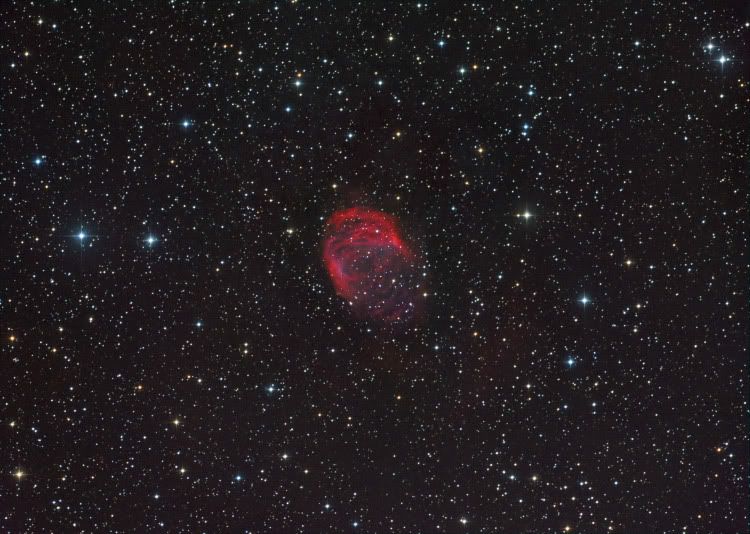
(Photo: Johannes Schedler, http://panther-observatory.com)

(Photo: Johannes Schedler, http://panther-observatory.com)
Azjah Telyria Danaan
Marchioness von Triberg
Baroness von Drachen Walde
Marchioness von Triberg
Baroness von Drachen Walde
- Azjah von Drachen Walde
- Expert Adventurer

- Posts: 1138
- Joined: Mon Apr 04, 2005 1:13 am
- Location: Palazzo Drachen Walde
- Contact:
Cigar Nebula
The chairs lean forward and the faint red glow is abruptly scattered and splashed across the blackness as a brilliant white disk resolves behind the splash of crimson. The Flaming Cigar (M82) streaks across the heavens. The stars being born here are born at a rate ten times faster than within our own Milky Way Galaxy. M82 is located 11 million light years away in the constellation Ursa Major, and is classified as a “starburst” galaxy. This image shows the galactic disk edge on, with huge plumes of hydrogen gas spraying from the galaxy’s center due to the vigorous stellar winds blasting from its many hot, newborn stars. This stellar baby boom was caused by a past interaction with another spiral galaxy, M81, which lies only 150,000 light years from M82.
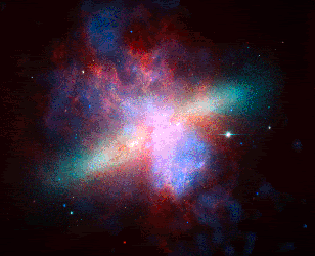
(Photo: NASA, ESA, The Hubble Heritage Team (STScI/AURA) J. Gallagher (University of Wisconsin) M. Mountain and P Puxley (National Science Foundation)

(Photo: NASA, ESA, The Hubble Heritage Team (STScI/AURA) J. Gallagher (University of Wisconsin) M. Mountain and P Puxley (National Science Foundation)
Azjah Telyria Danaan
Marchioness von Triberg
Baroness von Drachen Walde
Marchioness von Triberg
Baroness von Drachen Walde
Who is online
Users browsing this forum: No registered users and 0 guests
